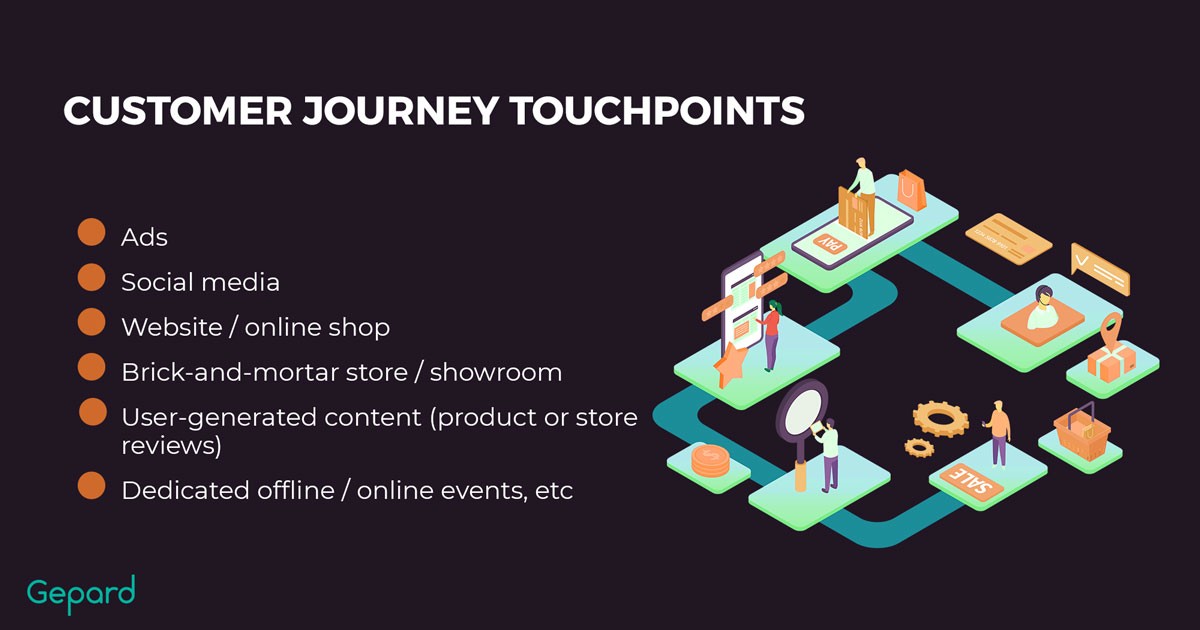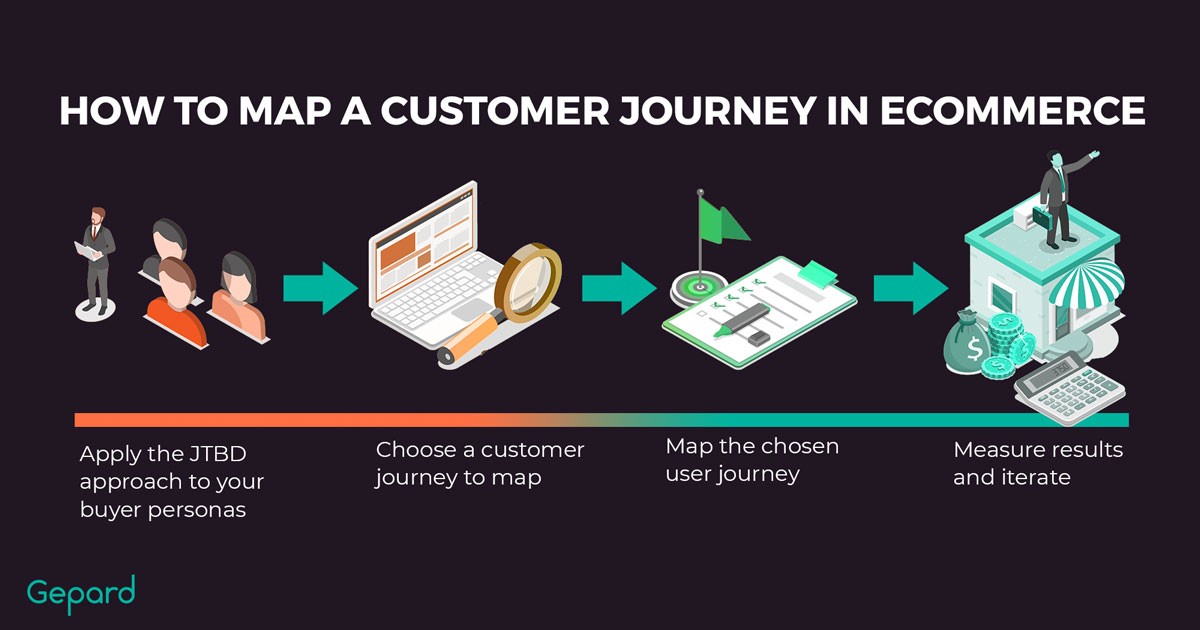Customer Journey Map For eCommerce Website
Nowadays, attracting a target audience to your business is quite a challenge. It’s a long way before your potential client becomes your customer. In times of high competitiveness, you should prepare a well-planned customer journey map to get those clicks and upscale your sales.
What Is A Customer Journey Map?
What Is A Customer Journey?
First of all, let’s examine the concept of the customer journey. It is the steps the buyer takes to interact with your business from the first click to the completed checkout. By mapping out these steps, you will understand your potential clients better.
For example, a person may find out about your brand from an influencer on social media. They will look at your business page but may close it due to some distracting factors. Then they might see you in the targeted ad. If they decide to follow it, they will recognize your brand and may choose a product they want to buy and add it to their shopping list. However, it doesn’t mean that they will buy it at once. They may come back to it in a week but also add something else to the shopping cart. This whole process from discovering your business to making a purchase is an example of a customer journey.
What Is A JTBD (Jobs To Be Done) Approach?
A Jobs-to-be-done approach relies on the presumption that the more ways the product can be used, the more valuable and popular it becomes. For example, a smartphone has thousands of uses, from news reading to conference meetings. Therefore, it is one the most popular products as almost every person owns it.
This approach is relevant for customer journey mapping as it provides the purchaser’s perspective to engagement with your brand. This way allows building a stronger connection and better engagement with the client, as opposed to creating CJM from the company’s point of view. It will help understand what and how the customer will most likely purchase from you. It is implemented with in-depth one-on-one interviews involving 10-15% of your brand’s customers. An interviewer needs to find out what caused your buyer to choose your brand and find out their specific purchaser journey. Here are the questions that can be used: How did you look for a solution to your pain point? What led you to purchase? How and when did you make the decision to purchase from our brand?
JTBD sets your mind on the client’s logic and will allow you to see what they really need. As Harvard Business School professor Theodore Levitt said: “People don’t want quarter-inch drill bits. They want quarter-inch holes”. Thus, a JTBD approach provides actionable insights in creating a customer journey map, rather than simply improvements to the already existing ones. The company’s job is not to block the buyer’s move through the journey map but to provide any option the customer wants to choose.
Some Examples Of Touchpoints In A Customer Journey
As we’ve already mentioned, from the time the customer finds out about your brand to their purchase, they do many different actions. They are called digital touchpoints. These are the moments of buyers’ interaction with your brand during their eCommerce customer journey.
Touchpoints can be ads, social media posts, website visits, and product or store reviews. They attract the client’s attention and compel them to engage with your business. The buyer gains experience with your brand by going through those various touchpoints.

Every customer journey is specific, however, it has been estimated that it takes an average of seven interactions with your brand before the purchase is made. Your shopper’s acquaintance with your brand may begin with a targeted ad on social media. Then they will visit your social media page and look through your posts. After that, they may visit your website and subscribe to your newsletters. Then they may find an interesting offer in your letter and finally make the purchase.
Stages Of A Customer Journey
Throughout their customer journey, the user goes through several stages. These stages include awareness, consideration, decision, buying experience, loyalty, and repeated purchase. Every stage includes different touchpoints for the buyer to engage with your business.
Awareness
At this stage of the user journey, the buyer finds out about your business and starts engaging with it. The awareness stage can include the following touchpoints:
- Ads. Your potential client may find out about your platform by clicking on Google Ads or via other advertising services.
- Recommendations. Word-of-mouth recommendations are also an effective way of raising brand awareness.
- Social media. You can raise awareness of your brand by posting on social media channels, such as Facebook, Instagram, YouTube, Twitter, LinkedIn and Pinterest.
- Google. Google’s tools, such as Google Analytics, Google Trends, Google Ads, and Google Tag Manager, can help you appear high in search so that your potential regular notices your platform.
Consideration
After acquaintance with your platform, the shopper starts comparing your service with competitors. The potential client considers the option that provides the best solutions to their problems.
- Reviews. The buyer will study the reviews of your business created by other users on your website, social media, or on review platforms.
- Remarketing ads. You may remind your visitors about your brand by retargeting ads.
- Promo emails. Your clientele may be interested in your offers getting promo emails. Email marketing allows for the creation of targeted and personalized content that reaches the right people at the right time. Also, it will allow you to conduct surveys and collect feedback.
- Product pages. The potential client will look through your product pages to study your business. Therefore, it is crucial to have full and truthful information about your products and their description to create a smooth customer experience.
Decision
The next stage in the customer journey map comes when the purchaser chooses you. They will take some actions that will lead them to purchase.
- Adding a product to the cart. When the buyer decides to buy a product, they will first add it to the cart. However, it does not necessarily mean that the purchase will be complete in the next step. People may be distracted by other ads or various circumstances and may leave the cart abandoned.
- Applying for installment payments. The buyer may apply for dividing installments into several payments if they are not ready to pay the whole sum in one installment but still want to buy the solution you offer.
Owning & Creating Buying Experience
After making a purchase, the purchaser will move on to communication with the support service if they have any further questions or concerns about your platform.
- Customer support. You need a good team that can provide high-quality support to help your regulars in case they have any questions about your product. You can provide customer support with chats, chatbots, real-time calls, communication with operators etc.
- Customer service. If the buyers get any problems with your product, you should be able to provide proper service to avoid dissatisfaction. Your product will also be more buyer-oriented if you can provide a guarantee that is valid for some time.
- Refunds/returns flows. If you cannot fix the problem with your product, offer a refund or return option to prevent a bad shopping experience.
Loyalty
If your buyer trusts your brand and hasn’t found any better solutions on the market, next time they will visit your platform once they make up their mind to buy something.
Eliminating the awareness and consideration stages when buying next time means loyal clientele will immediately go to your platform once they think of what they need. You can achieve brand loyalty by constantly engaging with your clients via social media, newsletters, targeted ads, etc.
Repeat Purchase
If the buyer is completely satisfied with your brand, they will repeat the purchases in the future. You can set up a repeat purchase to make their user journey easier.
- Activation emails. You may send emails to remind your regular shoppers to renew your product version every once in a while.
- Communication with managers. Your client may want to repeat a purchase when they communicate with your managers.

How To Map A Customer Journey In eCommerce?
Apply The JTBD Approach To Your Buyer Personas
A jobs-to-be-done approach provides opportunities to connect to your buyer persona by understanding their behavior better. Therefore, It is efficient in eCommerce customer journey mapping for enhancing shopper experience. If you know that your buyer persona prefers a certain type of cosmetics, you can offer them to add additional items of the same trademark within a minute of their purchase.
Choose A Customer Journey To Map
Every buyer persona is different and has different behavior in the website journey. Therefore, it is likely that your store will have a few user journeys at once. You need to test your website for problematic experiences to fix an issue journey. Your platform also needs to provide opportunities for other customer journey maps. Also, if the client added some items to the cart but didn’t complete the purchase, you can remind them to renew their buyer journey in a few days by email.
Map The Chosen User Journey
To map a user journey, you need to find answers to certain questions. These questions include: who takes part in the journey, what are their needs or pain points, what are the processes of the user journey, what is the behavior of your buyer persona etc.
Measure Results and Iterate
Mapping the customer journey in eCommerce resembles a design thinking methodology. This methodology is efficient not only in design but in managing other projects as well. Design thinking is a buyer persona-oriented approach to developing projects that connect the needs of people, tech capabilities, and business processes.
The goal of all these steps in mapping the eCommerce customer journey is to provide the necessary points to satisfy the customer and polish your platform’s buying experience.

eCommerce Customer Journey Map FAQ
Why Map Customer Journeys?
Mapping the customer journey is very important for your platform. It will help you provide the best solutions to your shopper’s needs. The mapping process will also improve the customer experience by making it more personalized to your buyer persona. A well-developed buyer journey map will upscale your business.
What Is The Goal Of A Customer Journey Map?
The ultimate goal of mapping the customer’s journey is to understand your customers better and ensure the best quality of their shopping experience.
What Is The Difference Between A Customer Journey Map And An Experience Map?
Customer journey and experience maps are similar. However, while the first one is about the processes the purchaser goes through when completing the purchase, the shopper experience map is concerned with the emotional and psychological satisfaction of the services you provide.
Is Customer Journey Mapping Inevitable?
With the increase of competition in eCommerce platforms and improvement of customer experience, mapping a customer journey is becoming a must for brands, manufacturers, retailers, and other market players to stay on top of the competition. Buying experience becomes more and more crucial to keep sales on the top and satisfy customers.
Throughout their Journey future buyers constantly consume information. Therefore, top-quality product data is an essential part of buyer journey mapping. To develop a well-functioning customer journey, it should be enriched, verified, and standardized.
Gepard can help your eCommerce operations to manage product information efficiently. It is especially relevant for brands and manufacturers that sell many products and have to syndicate the product content to deliver it to different sales channels rapidly and taking into consideration all the buyer’s journey maps. Want to learn how a PIM solution can facilitate your customer journey? Book your free personalized demo now.




